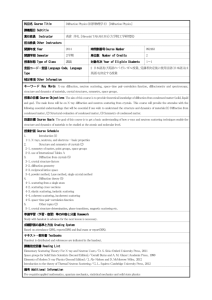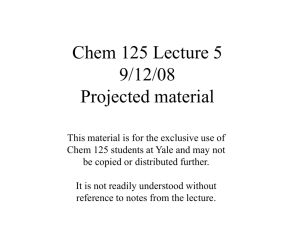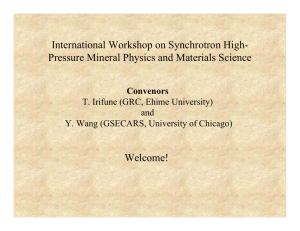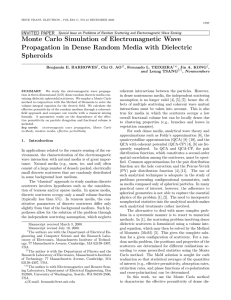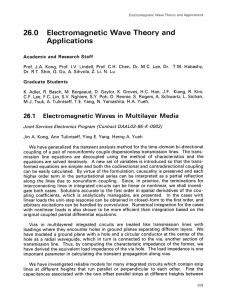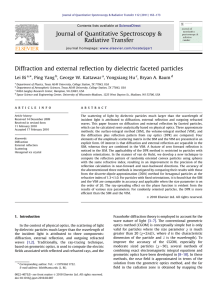18.369: Mathematical Methods in Nanophotonics overview lecture slides
advertisement
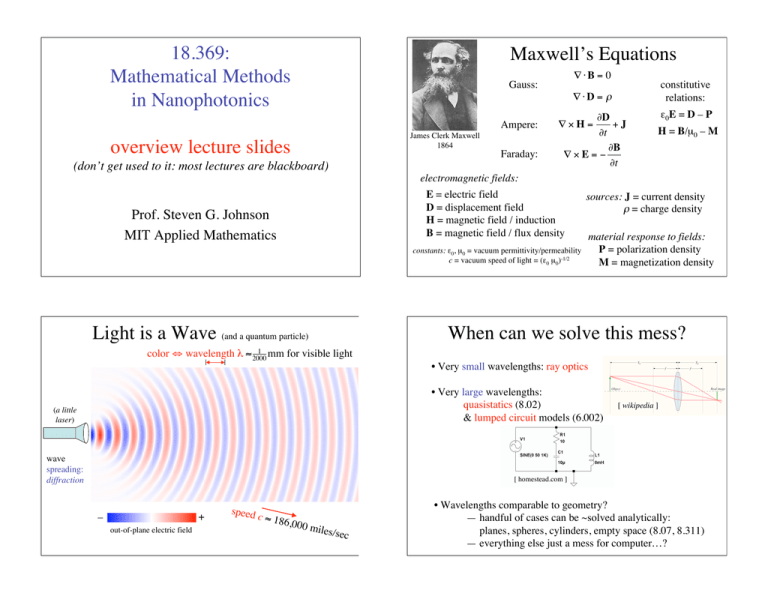
18.369: Mathematical Methods in Nanophotonics Maxwell’s Equations !"B = 0 Gauss: constitutive relations: !"D = # Ampere: James Clerk Maxwell 1864 overview lecture slides Faraday: (don’t get used to it: most lectures are blackboard) #D +J #t $B !"E=# $t !"H= "0E = D – P H = B/µ0 – M electromagnetic fields: E = electric field D = displacement field H = magnetic field / induction B = magnetic field / flux density Prof. Steven G. Johnson MIT Applied Mathematics sources: J = current density ! = charge density constants: "0, µ0 = vacuum permittivity/permeability c = vacuum speed of light = ("0 µ0)-1/2 Light is a Wave (and a quantum particle) material response to fields: P = polarization density M = magnetization density When can we solve this mess? 1 mm for visible light color # wavelength $ % 2000 • Very small wavelengths: ray optics • Very large wavelengths: quasistatics (8.02) & lumped circuit models (6.002) (a little laser) wave spreading: diffraction [ wikipedia ] [ homestead.com ] + – out-of-plane electric field speed c % 18 6,000 miles/ sec • Wavelengths comparable to geometry? — handful of cases can be ~solved analytically: planes, spheres, cylinders, empty space (8.07, 8.311) — everything else just a mess for computer…? small particles: Lord Rayleigh (1871) why the sky is blue Waves Can Scatter here: a little circular speck of silicon checkerboard pattern: interference of waves traveling in different directions Multiple Scattering is Just Messier? here: scattering off three specks of silicon can be solved on a computer, but not terribly interesting… scattering by spheres: solved by Gustave Mie (1908) An even bigger mess? zillons of scatterers Blech, light will just scatter like crazy and go all over the place … how boring! Not so messy, not so boring… the light seems to form several coherent beams that propagate without scattering … and almost without diffraction (supercollimation) …the magic of symmetry… A slight change? Shrink $ by 20% an “optical insulator” (photonic bandgap) Noether’s theorem: symmetry = conservation laws In this case, periodicity = conserved “momentum” = wave solutions without scattering [ Bloch waves ] Felix Bloch (1928) [ Emmy Noether, 1915 ] light cannot penetrate the structure at this wavelength! all of the scattering destructively interferes Mathematically, use structure of the equations, not explicit solution: linear algebra, group theory, functional analysis, … Photonic Crystals: Structural Color in Nature periodic structures for light crystalline minerals: periodic atoms bandgap = wavelength-selective mirror = bright iridescent colors synthetic microstructures opals morpho rhetenor Lots of math to understand this… …linear algebra: silicon: r %$ (2 r 1 !" !"H =' * H & c) # [ wikipedia.org ] (eigenproblem) [ wikipedia ] [ Lin, 1998 ] …symmetry & group representation theory …computational methods… [ S. K. Bose, brocku.ca ] bandgaps = insulators & semiconductors [ Vlasov, 2001 ] …many open questions… wing scale: [ P. Vukosic (1999) ] also peacocks, beetles, … 3µm http://www.icmm.csic.es/cefe/ Light Confinement for Surgery Molding Diffraction for Lighting [ another MIT startup (by a colleague): Luminus.com ] fiber cross-section ultra-bright/efficient LEDs hollow core MIT startup: omni-guide.com periodic pattern gathers & redirects it in one direction new projection TVs, pocket projectors, lighting applications, … Periodic layering confines laser light that would vaporize glass within a hollow core Used for endoscopic surgery Back to Maxwell, with some simplifications Simplified Maxwell !"H = 0 ! " #E = 0 • source-free equations (propagation of light, not creation): J = 0, ! = 0 • Linear, dispersionless (instantaneous response) materials: P = "0 'e E M = 'm H (nonlinearities very weak in EM … we’ll treat later) (dispersion can be negligible in narrow enough bandwidth) & D = "0 (1+'e) E = "0 "r E B = µ0 (1+'m) H = µ0 µr H where "r = 1+'e = relative permittivity or dielectric constant (drop r subscript) µr = 1+'m = relative permeability "µ = (refractive index)2 • Isotropic materials: ", µ = scalars (not matrices) • Non-magnetic materials: µ = 1 (true at optical/infrared) • Lossless, transparent materials: " real, > 0 (< 0 for metals…bad at infrared) ! " H = # 0# (x) $E $t ! " E = # µ0 µ $H $H = # µ0 $t $t • Linear, time-invariant system: & look for sinusoidal solutions E(x,t) = E(x)e–i(t, H(x,t) = H(x)e–i(t (i.e. Fourier transform) ! " H = #i$% 0% (x)E [ note: real materials have dispersion: " depends on ( = non-instantaneous response ] ! " E = i#µ0 H … these, we can work with
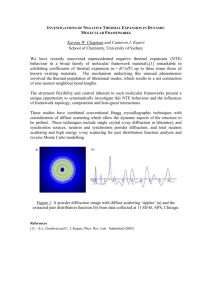



![科目名 Course Title Diffraction Physics [回折結晶学E] 講義題目](http://s3.studylib.net/store/data/006888522_1-a6b112ac7120ea571e1192b9298646bc-300x300.png)
